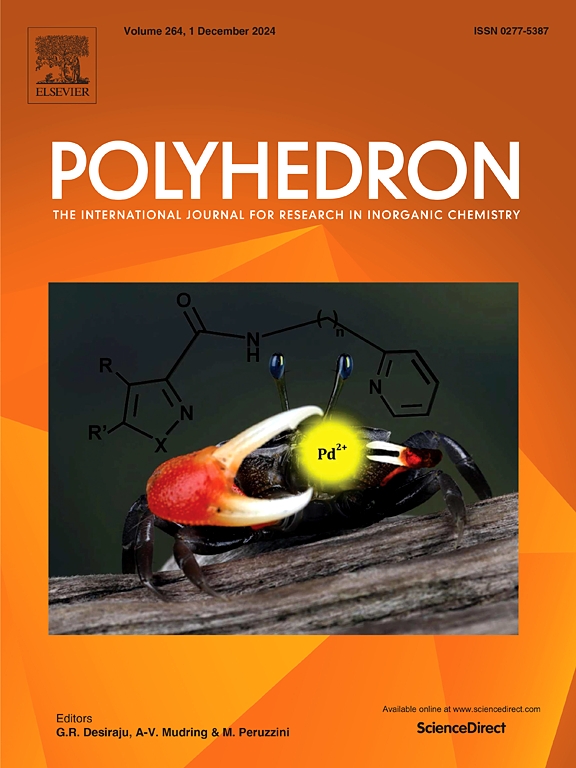配位种与5-磺基水杨酸酯的磁相互作用
IF 2.4
3区 化学
Q2 CHEMISTRY, INORGANIC & NUCLEAR
引用次数: 0
摘要
5-磺基水杨酸(H3L)具有三个潜在的配位基(羧基、磺酸基和羟基),它们可以去质子化并与金属离子实现多种配位选择。这包括桥接模式,这是一种在相邻金属离子之间实现更强磁相互作用的合适方式。合成了几种新型的5-磺基水杨酸配位化合物,并对其进行了表征。它们是{[Cu(inia)(HL)(H2O)2](H2O)2}n 1 (inia -异烟碱酰胺,C6H6N2O), [Zn(inia)2(HL)(H2O)2](H2O) 2, Co(inia)(HL)(H2O) 5.3, {(CH6N3)2[Cu(L)(H2O)]2(2OHpy)4} 4 (2OHpy−2-羟基吡啶,C5H5NO;CH6N3+−胍离子)和(CH6N3)Cu(L)(H2O) 5。单晶XRD分析显示了1、2和4的结构排列。CHN和IR分析与结构数据相吻合,并对3和5提出了合理的计算公式。发现4 (J =−116 cm−1/ mol Cu(II))与一对短单原子Cu∙∙∙∙O∙∙Cu ‘配位桥(Cu∙∙∙O 1.941/ Cu ’∙∙∙O 1.998 Å)具有强反铁磁(AFM)偶联,在配位多阴离子内显示伪二聚体。由于1中没有这样的短接触,磁隔离的Cu(II)存在于中性配位公式中,而抗磁性的Zn(II)存在于2中。此外,在5 (J = - 126 cm−1/mol Cu(II))中也存在强的AFM耦合,其公式也表明离子成分与4相同。钴化合物3在几乎磁隔离的Co(II)中只有一个小的轨道贡献L,得到D = 56.5 cm−1,E = - 0.34 cm−1,zJ = - 0.011 cm−1。本文章由计算机程序翻译,如有差异,请以英文原文为准。

Magnetic interactions in coordination species with 5-sulfosalicylates
5-sulfosalicylic acid (H3L) poses three potential coordination groups (carboxylic, sulfonic and hydroxylic) that can deprotonate and enable versatile coordination options with metal ions. This includes a bridging mode, a suitable way to enable stronger magnetic interactions, among adjacent metal ions. Several novel coordination compounds with 5-sulfosalicylates were synthesized and characterized. These are {[Cu(inia)(HL)(H2O)2](H2O)2}n 1 (inia – isonicotinamide, C6H6N2O), [Zn(inia)2(HL)(H2O)2](H2O) 2, Co(inia)(HL)(H2O)5 3, {(CH6N3)2[Cu(L)(H2O)]2(2OHpy)4} 4 (2OHpy − 2-hydroxypyridine, C5H5NO; CH6N3+ − guanidinium cation), and (CH6N3)Cu(L)(H2O) 5. A single crystal XRD analysis reveals structural arrangement of 1, 2 and 4. CHN and IR analyses corroborate with the structural data and propose rational formulae also for 3 and 5. A strong antiferromagnetic (AFM) coupling is found for 4 (J = −116 cm−1/ mol Cu(II)) being in agreement with a pair short monoatomic Cu∙∙∙O∙∙∙Cu’ coordination bridges (Cu∙∙∙O 1.941/ Cu’∙∙∙O 1.998 Å) showing pseudo dimers within coordination polyanions. As no such short contacts are seen for 1, the magnetically isolated Cu(II) are present in a neutral coordination formulae, while diamagnetic Zn(II) is in 2. Additionally, a strong AFM coupling is present also in 5 (J = −126 cm−1/mol Cu(II)) with a formulae also suggesting ionic constituents as in 4. The cobalt compound 3 reveals only a small orbital contribution L within almost magnetically isolated Co(II), giving D = 56.5 cm−1, E = −0.34 cm−1, and zJ = −0.011 cm−1.
求助全文
通过发布文献求助,成功后即可免费获取论文全文。
去求助
来源期刊

Polyhedron
化学-晶体学
CiteScore
4.90
自引率
7.70%
发文量
515
审稿时长
2 months
期刊介绍:
Polyhedron publishes original, fundamental, experimental and theoretical work of the highest quality in all the major areas of inorganic chemistry. This includes synthetic chemistry, coordination chemistry, organometallic chemistry, bioinorganic chemistry, and solid-state and materials chemistry.
Papers should be significant pieces of work, and all new compounds must be appropriately characterized. The inclusion of single-crystal X-ray structural data is strongly encouraged, but papers reporting only the X-ray structure determination of a single compound will usually not be considered. Papers on solid-state or materials chemistry will be expected to have a significant molecular chemistry component (such as the synthesis and characterization of the molecular precursors and/or a systematic study of the use of different precursors or reaction conditions) or demonstrate a cutting-edge application (for example inorganic materials for energy applications). Papers dealing only with stability constants are not considered.
 求助内容:
求助内容: 应助结果提醒方式:
应助结果提醒方式:


